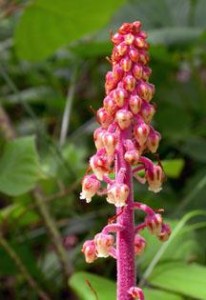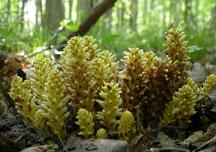Phantoms of the woods
- Share
- Tweet
- Pin
- Share
It was on the last Saturday of June, during the highly interesting and informative Bioblitz within the northern part of Newport State Park, that we came upon quite a few Partridgeberry wildflowers in bloom.
Because my sidesack was filled with field guides and other study materials, I chose to not pack my camera. Naturally, that turned out to be a big mistake because that very beautiful little double-tubed wildflower was one I had never photographed.
Early the following morning, while successfully searching for these wildflowers at the Meridian County Park, I was very surprised to come upon a small cluster of Indian Pipes, around four inches tall, poking their way out of the decayed leaves on the forest floor. Ordinarily I expect to find them at their best around mid-to-late July. Most people take a look at one of the colorless plants and immediately assume it is a fungus which, like all others, lacks chlorophyll. Those hikers find it hard to believe me when I tell them the “ghost pipes” belong to the Blueberry family and are close relatives of the Bearberry, Wintergreen, Bog Rosemary, Trailing Arbutus and Cranberry. Another extremely rare member of this fascinating family, which I will get to later, is the Pine-drops.
It is difficult to imagine that a seed-producing flower can be colorless. A mass of brittle, white, fiber-like roots obtain this mystic plant’s food mostly from decomposing plant matter. This qualifies it to be classified as a saprophyte. It also derives a small amount of its nourishment from living roots giving it parasitic tendencies as well.
Its generic name, Monotropa (mon-o-TRO-pa), means one turn. At an early state of its development the flowering stem is turned to one side, then bends upward as the seeds ripen. The species name, uniflora, tells us it is a one-flowered blossom. Each waxy clammy blossom grows from a scape, a naked flowering stem arising from the ground.
The blossom hangs head downward for a few weeks as its develops, then slowly turns upward. Now it is time to peer into the opened “pipe bowl” to see that it really does have some color, the exquisite yellow stamens arranged in a neat circle around the edge of the round ovary. Occasionally a few of the delicate waxy plants, backlit by the early morning sun, will reveal a beautiful pink pearly translucence. Fortunately Indian Pipes are quite common and can be found growing in mixed hardwoods and also conifer woods throughout the county.
Another truly exciting wildflower find occurred recently after searching unsuccessfully in the county for the elusive plant for over 40 years. My good friend and expert wildflower photographer from LaCrosse, John Zoerb, located and photographed Pine-drops at the Ridges Sanctuary during the summer of 1967. Apparently John assumed I knew about the rare plant’s location because he didn’t tell me of his find. When he did “spill the beans” several years later, search as I did I could never locate it. That happens to be the nature of this endangered Wisconsin novel plant, which can grow to be three feet tall, completely lacking chlorophyll like the Indian Pipes. For unknown reasons, some rare plants simply perish, and this is what was assumed by the plant experts to be the situation with Pine-drops in the state.
What made the discovery doubly exciting for me was that I was botanizing with my good friends, Gary Fewless, botanist at the University of Wisconsn – Green Bay, and Joel Trick, with the U.S. Fish and Wildlife Service out of Green Bay. Neither of them had seen the rare Pine-drops up to that eventful day. They had worked on their masters degrees in 1982 at the Toft Point State Natural Area, which is when I came to know and greatly respect them as excellent field naturalists and botanists.
What’s so unusual about the Pine-drops, Pterospora andromedea (ter-OS-por-a an-dro-MEAD-e-a), is that, in spite of its extreme rarity, each of its many tiny flowers can produce 4,800 minute, winged, wind-spread seeds. This means a single plant can produce as many as 600,000 seeds!
Usually this plant is found in humus-rich forests under White Pine trees, precisely where we found the foot-tall plants growing. The plant relies entirely upon dead organic matter for food. Underground it has a massive snarl of branching roots, which, in partnership with various soil fungi, absorb nutrients from decaying plant and animal matter.
Pine-drops grow mainly in western mountainous North America, south to Mexico and north to British Columbia. They are scattered and rare throughout northeastern US and southeastern Canada.
Another strange and fascinating perennial plant lacking chlorophyll, which we expect to stumble onto soon in the woods, perhaps while mushrooming, is the American Cancer-root, Conopholis americana (co-NOF-o-lis). Its old, politically incorrect name of Squaw-root has been discontinued. This is a parasitic plant with yellow to cream-colored, densely-crowded flowers emerging among pointed, yellow-tan scales on the upper part of a fleshy stalk. They resemble pinecones as they dry with age. Another colloquialism is “bear corn” because they do resemble four-to-six-inch cobs of corn poking out of the ground. They are parasitic on the roots of oaks and possibly beeches.
Rarely will your hikes through the woods within the next several weeks reward you as wonderfully and surprisingly as when you discover some of these exotic chlorophyll-lacking plants that surely possess virtuous charms, the Indian Pipes, Pine-drops and American Cancer-root, phantoms of the woods.



